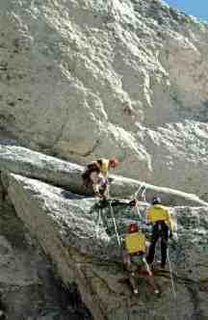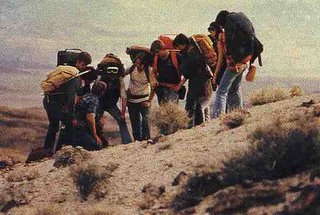A
shelter should at least offer
protection from wind and weather and the sun. A shelter provides a feeling of
safety and
security as well. Thus, a shelter eases, though perhaps only temporary, psychological stress.
Naturally, you won't build your shelter just anywhere. Pits, holes and dips in the terrain can fill up with water after rain or, through poor permeability of the soil or rising ground water levels, could become soggy and marshy. When possible, remain at least 10 meters above any nearby water level. Dry river beds, wadis and innocently-looking brooklets can turn into swirling rivers after a downpour, even if that happened miles away.
Reservoirs can also exhibit rising and dropping water levels. Water is let out of the lake during the day to generate electricity, while at night the water is stored inside the reservoir. The differences in water level can be several meters. This once caused my camp to be nearly flooded in the time it took us to cook a meal. In many different areas, snakes live close to the water edge, as do mosquitoes, flies and other insects.
Avoid narrow crevices and gorges, overhanging rocks and erosion gullies. Rocks, stones and toher
erosion material can fall down there. Never make camp either in places with a high chance of avalanches, and definitely not in the avalanche path.
Many animals try to avoid open spaces, making them good places for you to build
camp if you want to lessen the nuisance small, nightly critters can cause. Collect fire wood from nearby, so you can leave a fire burning to ward off animals. Food, provisions and supplies are best stored in a strong, tightly closed bag, which you hang from a branch in a tree. Make sure the bag hangs at least two meters from the tree trunk, about three meters from the ground
and about three meters from the branch it's hanging from as well. You don't want large animals to be able to reach up the bag, or small animals to reach down from a branch. The heat of the day lingers longer under plant and tree cover. During a thunderstorm you better not camp or take shelter under trees, but avoid open and bare hill tops as well.
In an
emergency situation, you want to be rescued or at least find help. So, make sure that even when you made camp under tree cover, a
rescue team can see you from the air or a mountain slope. During the, mark your camp with eye-catching colours (orange is a good colour for that) and a sign. After sundown, light three fires in a row. This is an international emergency signal!
Technorati Tags : survival techniques scouting Boy Scouts hiking orienting camping trail primitive sustainable alternative modern technology Shards of Survival




